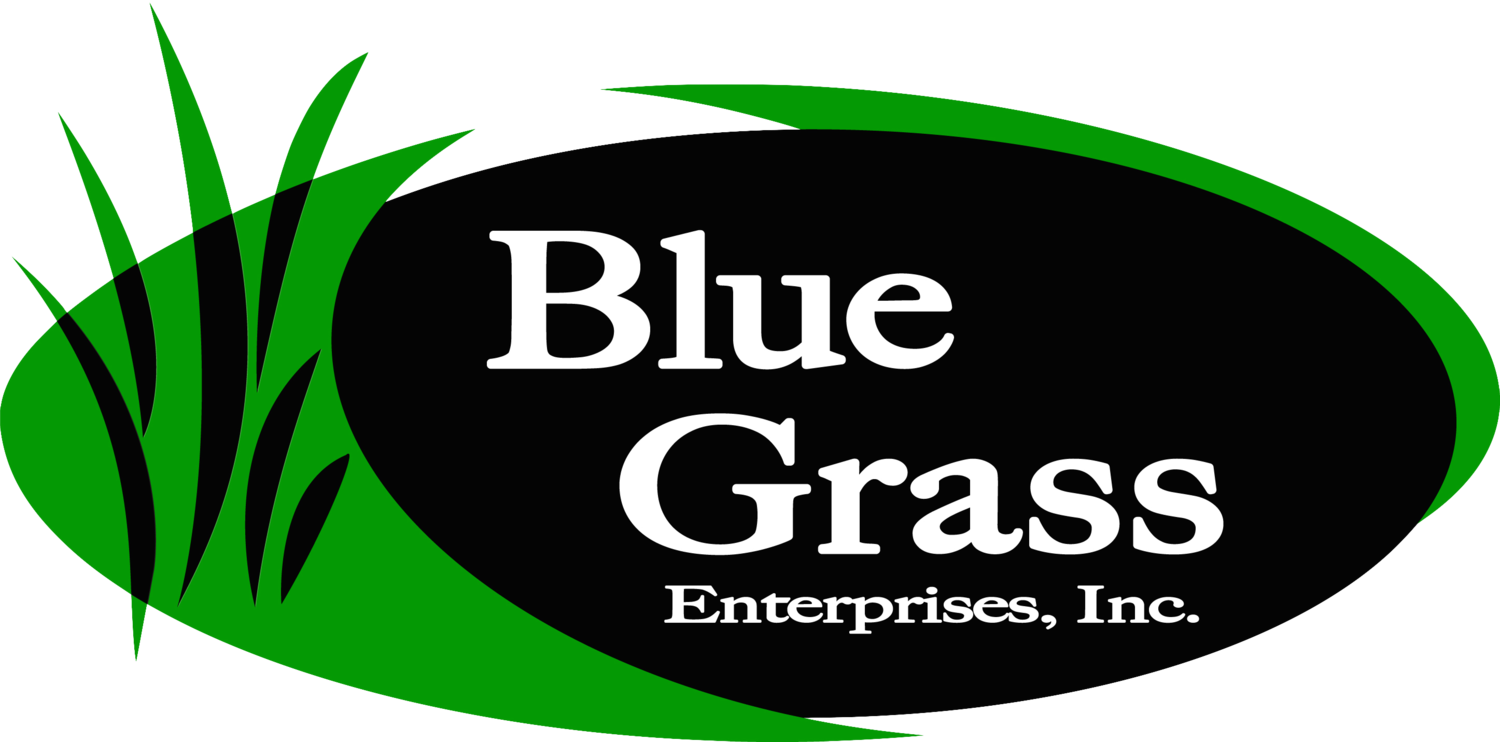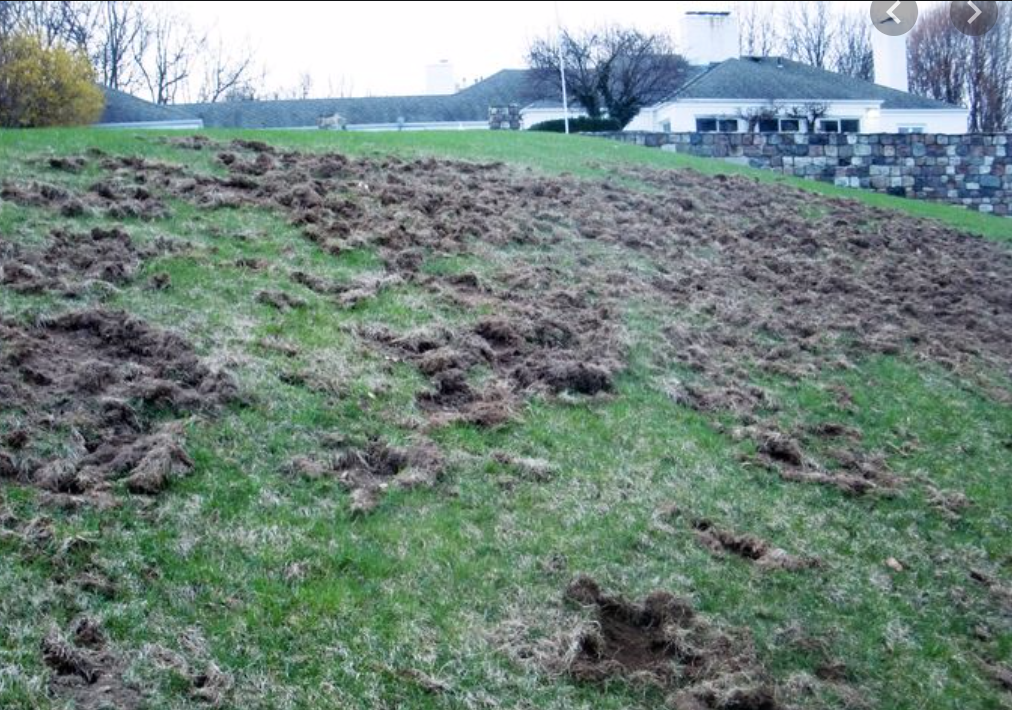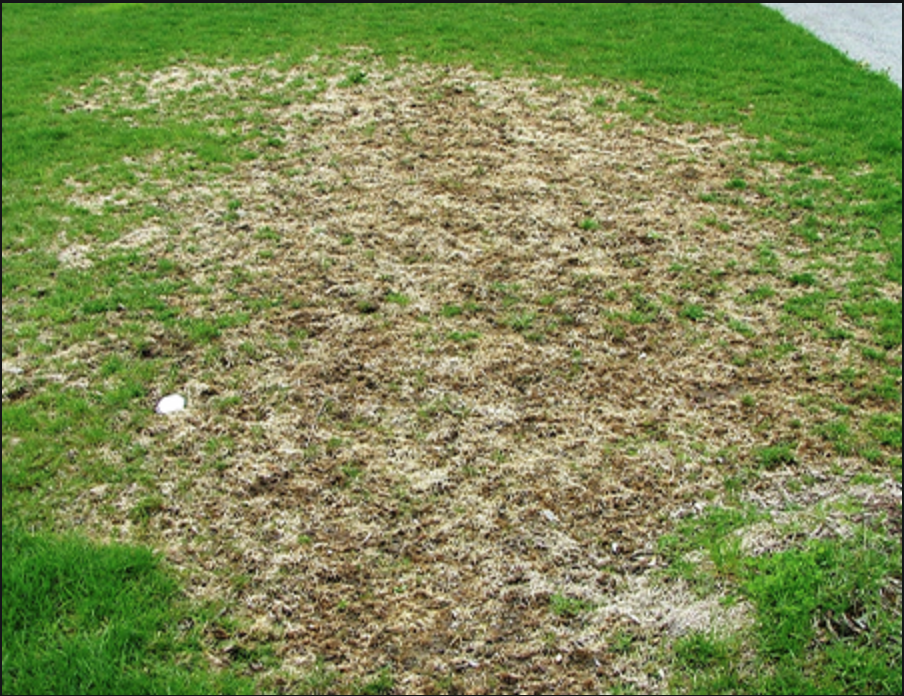The lifecycle of a Japanese beetle (source Ohio State University).
So, you found some grubs.
I have great news. You don’t need to panic! Yay!
In the US, we sometimes forget that grubs are normal. In fact, having some grubs in your lawn is a sign of a normal functioning ecosystem. Much like earthworms, centipedes, and other crawly-critters, grubs are supposed to be there and serve a function in the food chain of your surrounding environment.
Despite being kind of gross looking, grubs are not inherently evil.
However, unlike their insect friends, grubs have the ability to become a bigger issue in the form of lawn damage (larvae form) or tree, shrub, or garden damage (when they turn into adult beetles). If you have ever seen hundreds of Japanese beetles swarm linden trees, rose bushes, and basil plants, you know what I mean.
what are my options regarding grubs in my lawn?
Here is an excerpt from an article by entomologist Dr. Don Lewis from Iowa State University:
Recent grub damage. Because grub damage can look similar to other damage in lawns, it is important to dig in the area to see if you can confirm there is an infestation.
“White grub populations and damage to lawns vary greatly from year to year and place to place, even varying from spot to spot within the same lawn due to variations in beetle numbers, weather, turfgrass vigor, soil conditions, and other factors. There is no method that predicts if and where grubs will occur or how severe the damage will be.
What happens in your lawn this summer is a random event and not directly tied to previous experience. Therefore, decisions concerning white grub management are difficult; there is no one right answer for everyone.
There are three basic approaches to grub management in the home lawn, depending on your tolerance for damage, comfort with pesticides, and willingness to spend the cash. White grub insecticide treatments are not only expensive but hard to justify from an environmental standpoint.
In places such as golf courses and some lawns, the risk of any white grub damage is so intolerable that preventive insecticides are applied to every part of the lawn, every year. When this approach is chosen, the proper time of application is [either in May or] between early June and Aug. 15 [depending on the product being used]. A compromise modification of the golf course approach is to treat only those areas that have been previously damaged. Beetles tend to return to the same areas in successive years, so it is logical to treat the areas where the grubs were last year or the year before.
The second approach is the “wait-and-see” approach. Watch the lawn carefully for early signs of damage (wilting, turning brown) during August to early September when grubs could be feeding. Apply a curative insecticide only where and when needed. The risk is that you might still lose some sod, especially if summer rainfall or irrigation keeps the grass growing and vigorous through July and August. Damage symptoms may not appear until after it is too late for effective treatment (late September through late October).
Unfortunately, raccoons and skunks are much better at locating grub populations than we are and the first symptom of a grub problem in your turf is likely to be that your lawn was "plowed" by varmints overnight.
Sometimes, the worst “grub damage” is from other animals like raccoons tracking down these “slimy, yet satisfying” snacks.
The final alternative is to do nothing. This may be easier to do if you count up how many years you DID NOT have grub damage. Divide the cost of replaced sod by that number of years. If the yearly-averaged cost is less than the price of insecticide, do nothing and take your lumps in the occasional year when damage occurs. This approach is much easier to follow if you believe "it's just grass, anyway.” - Dr. Don Lewis, ISU
FAQs on Grub Options
My lawn (and trees and garden) are important to me and I would like to put down a preventer to avoid damage. What are my options?
Step 2 of our Four-Step Program (32-0-5 with Dimension and Acelepryn) is a slow-release fertilizer that will feed your lawn for approximately 160 days, prevents weeds, and is an insect preventer that will impact white grubs (pictured right) that turn into June bugs, as well as other larvae that turn into Asiatic beetles, Japanese beetles, billbugs, and chinch bugs.
Is your grub preventer safe for bees?
Yes. Acelepryn is the only grub preventer currently available to homeowners that is labeled as being safe for pollinators, such as bees.
Will a grub preventer affect Japanese beetles too?
Yes, our insect preventer will kill the grub larvae for Japanese beetles and June bugs. Acelepryn (our grub preventer) is also labeled for bluegrass billbug and sod webworm control as well.
Will either of your products kills mosquitos or gnats?
No.
I would prefer to not put down an insecticide. What do you recommend doing instead?
Our alternative Step 2 product is 20-0-5 w/ Dimension. This will feed the lawn and also prevent weeds like crabgrass. Information about our insecticide-free Four-Step Program is here. As long as you are comfortable with the possibility of a possible infestation later in the year. (Remember: outbreaks can be cured retroactively with Dylox, as mentioned above). This is an especially good solution for people with dogs who are trying to stay ahead of dog damage or for individuals who like to promote pollinator activity on their lawns.
I like the “wait and see” approach described by Dr. Lewis above. But how will I know if I have an infestation?
Insect damage tends to be easy to identify and generally shows up toward the end of July and in August. In the case of grubs, they will eat the root system of the plants, leaving the top growth to die in little “tufts” that are easy to pick up (because they are no longer rooted in.) You will want to dig around in the area that is showing damage to see if larvae are present. Remember that the definition of an actual infestation is if you have 10+ grubs per square foot in the affected area.
*fast forward to August*
Crap. I have confirmed I have a grub infestation in my yard. How do I stop it?
In the case of a true infestation (10+ grubs per square foot), we carry a product called Dylox which is a post-emergent curative. You will apply Dylox to the affected area, water it in with at least a half-inch of water to ensure the product reaches the grubs, and then in two weeks you can return with treatments of 13-13-13 to help the scarring fill in and repair the lawn.





